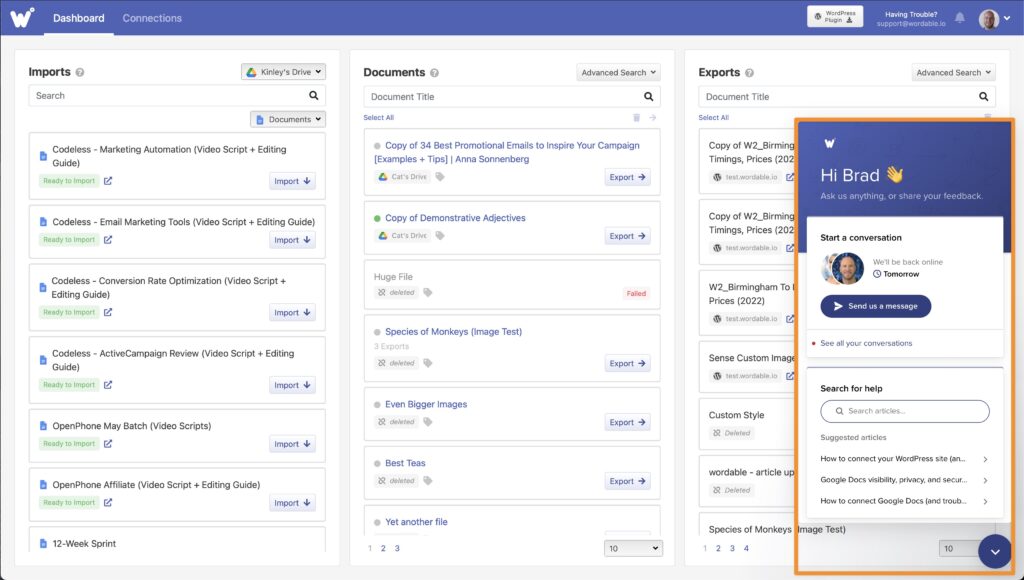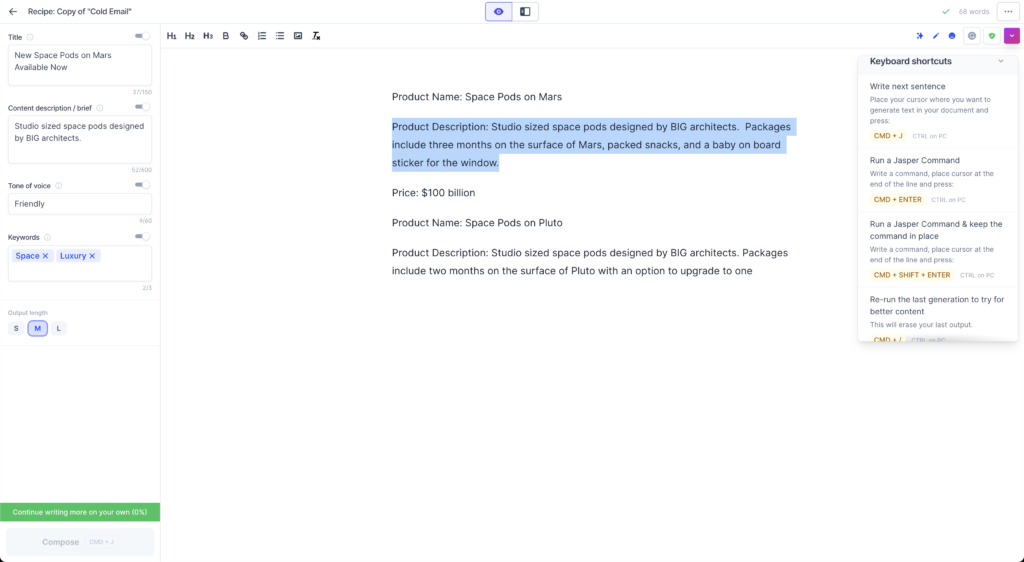Writing a quality blog post always takes time. Sometimes, you may simply face writer's block and feel unable to deliver your content in a reasonable timeframe.
Whether you're working to client deadlines, or just trying to accelerate the pace of your own blog, this is a source of significant stress for most writers, eventually leading to burnout.
To avoid this, many writers develop strategies to help speed up their writing without sacrificing quality. I've made a list of 15 tips that will help you write faster:
- Write an ugly draft first, edit it later
- Automate your non-writing tasks
- Use AI to prompt ideas
- Try voice dictation
- Use templates for common content formats
- Separate research & writing
- Write whenever works best for you
- Done is (sometimes) better than perfect
- Self-impose a time limit
- Write the intro last
- Use briefs & style guides to reduce edits
- Outsource your content writing
- Try a new time management technique
- Source expert quotes & insights
- Know when to call it a day
Let's go over each of these useful tips.
1. Write an ugly draft first, edit it later
Focusing too closely on the fine details like spelling, grammar, style, or conciseness can divert too much energy from the most important part — getting your ideas down on the page.
This can quickly tire you out and lead to a block. It's better to use your initial surge of inspiration to write a rough draft which you will polish later.
If you have an SEO editing process, leave that til later too. Dedicate your energy towards saying what you want to say, however it first comes to mind.
2. Automate your non-writing tasks
Preparing and publishing a blog post includes more tasks than simply writing an article. Tasks such as CMS uploading or image compression are simple but repetitive and time-consuming actions.
Spend a little time up front to think about all the tasks involved in your content workflows. Set up automations, and you'll reap the rewards for years after.
Here's a specific case, following on with the example of automating a CMS upload.
Most writers want to work in Google Docs. There are software tools available to convert a Google Doc into a WordPress post, and for other CMS too.
Use a tool such as Wordable to do this in one click, while keeping your formatting intact.

For even more tools & ideas for automating your content marketing and SEO tasks, see:
- 7 Content Marketing Automations to Save Time & Boost ROI
- 12 Content Marketing Automation Tools for Faster Workflows
- 12 Best AI SEO Tools for Automation & Speedy Content Creation
3. Use AI to prompt ideas
Writing content is a task that generally shouldn't be left to automation. Still, when facing writer's block, AI text-generation tools such as Jasper can help prompt ideas.

After generating a block of topical text, you can edit it into something more accurate, polished, and unique. Alternatively, you can choose to just reuse the general idea and rewrite the text from scratch.
Another AI text generator that can help you generate your first draft of ideas is Canva’s Magic Write, powered by OpenAI. To use it, you simply start with a prompt and the AI writer will generate outlines, blog posts, content ideas and more.
4. Try voice dictation
Long writing sessions can be exhausting, in more ways than mental strain. Sitting in front of the screen for hours can put a strain on your eyes, making it hard to continue typing. Plus, it's not uncommon to get pain/discomfort in the hands/wrists/upper body too.
If you find yourself in such a situation, you may be able to get through your writing tasks faster & more comfortably by using voice dictation.
Google Docs has a decent voice-to-text tool built in that you can use for free.
Otherwise, you can simply take a voice recording, and then use a free transcription software to convert it to text.
This works great if you're responsible for writing up transcripts for podcasts or videos too.
5. Use templates for common content formats
After a while, you will find that most of your blog posts will probably end up fitting one of only several common formats. For example, most articles on this blog fall into one of three categories: listicles, comparisons, and how-to posts.
You can take advantage of this to speed up your writing by using templates. After writing an article that you're happy with, you can save the outline and reuse it for later articles in a similar format. In the long term, this can save hours of your time.
6. Separate research & writing
One of the trickiest aspects of content writing is keeping focus. This is made even harder by having to juggle several tasks at hand, such as researching your content at the same time as writing it.
Therefore, it's smart to separate the two, so you can get into writing with an already-prepared outline of your article's content. Before starting to write, set aside a number of hours only for research and taking notes. This way, you won't need to make constant breaks in the middle of writing to look for information.
7. Write whenever works best for you
You don't need to be tied to the 9-5.
One of the biggest advantages of remote work is greater flexibility in regard to work hours. Most writers don't need to care about that – it's only important to deliver content before a set deadline if there's one.
This is perfect for creative tasks such as writing. If you find yourself facing a creative block, there's nothing stopping you from setting aside a few hours to recharge and leaving work for later. You can also schedule any time of day to be your regular writing time. If you feel like you're more productive in the evening, there's nothing stopping you from doing other things during the day.
8. Done is (sometimes) better than perfect
While we often value perfectionism as an admirable trait, it can be an impediment when needing to get things done. Plus, it's more often a reflection of imposter syndrome and other insecurities than of any real concerns. Focusing on fine details more than necessary takes away time that could be used on more important work. It also eats your energy, leading to faster burnout.
It's better to focus on getting your work out on time rather than making sure it looks “just perfect”. That said, you shouldn't settle for sloppiness. It's sometimes okay to sacrifice style and finesse, but never throw accuracy under the bus or publish a post full of obvious typos.
9. Self-impose a time limit
Overly long deadlines – or lack thereof – can lead to endless procrastination. This way, you can keep pushing your work schedule to the last moment, eventually leading to subpar articles written in a hurry.
Telling yourself you'll finish an article within a week, or within two or three days, means that you'll center your plans around fulfilling that goal. While setting a time limit in advance creates a greater sense of urgency, it saves you from the stress of cramming your article at the last moment. That also lets you work at a more relaxed pace, allowing you to take more breaks when necessary.
10. Write the intro last
Figuring out a way to begin your article often proves to be the trickiest part of writing. Many writers face creative blocks here, sometimes taking up to several days until they can start writing.
When this happens, a good idea is to leave the intro for later. It's usually easier to write an intro after writing out the main body of the article. If your article is pretty much finished, it shouldn't be hard to come up with a way to introduce the content in 100-200 words.
11. Use briefs & style guides to reduce edits
After finishing your post, you'll likely need to review it in order to fix the overall style and SEO. This can take up to several revisions and eat a good chunk of your time. However, you can reduce the number of edits by preparing an SEO content brief and a style guide in advance.
A content brief is a document that includes a set of instructions and recommendations to guide the writer in preparing the post. In the case of SEO, it should also suggest what is the search intent, what searchers are looking for, and how to satisfy that.
A style guide is a set of standards for the tone, grammar, formatting, and design of a document. Style guides can clarify solutions to various common dilemmas you may find yourself in while writing. Having such questions answered for you in advance saves a lot of time and effort. For a list of content style guides that you could use, see here.
12. Outsource your content writing
Having a team of writers lets you have a far greater impact than you could have alone. If you're an in-house content marketer with the budget to grow a team, or a blog author who has gained enough traction to scale, consider outsourcing writing.
If you have a personal network of writers who you trust, start your hiring efforts there.
Otherwise, I recommend offering paid trial tasks. Test out 5-10 writers, and keep 1-2 of the best, depending on their capacity.
You can use dedicated platforms such as Workello to screen and hire potential candidates. Workello helps you manage the entire hiring process: creating job ads, reviewing applications, creating and facilitating assessment tests, holding interviews, and sending job offers. The hiring pipeline is completely streamlined, letting you hire writers in only a matter of clicks.

13. Try a new time management technique
Effective time management is one of the most crucial factors for delivering consistently fast content. Most writers plan their time management intuitively and on the spot, but sometimes having to constantly figure out how to organize your time makes you indecisive and slows your work down.
Instead, you could use a tried and tested time management technique to establish a firmer routine. The most famous technique of the kind is the famous Pomodoro Technique, developed by Francesco Cirillo. The idea behind Pomodoro is to set a timer for 25 minutes, during which you will focus on a single task. Take a short 5-minute break, then repeat. After completing four 25-minute sessions, take a longer break between 15 and 30 minutes. Repeat until you finish your daily work quota.
14. Source expert quotes & insights
Whenever researching a topic, you should find expert quotes and insights which you could potentially reuse later. There are several reasons why you should do this.
Sourcing an expert opinion always gives authority and credence to your content. Even more importantly, those insights can act as a prompt for your own original content. Lastly, if you've got a word count quota, you can use these quotes as an easy but still substantial way to fill your word count in case of writer's block.
15. Know when to call it a day
Sometimes, deadlines may be creeping up but you feel like you're too tired to continue writing. In most cases, you shouldn't force yourself to commit to a task that you feel too exhausted to work on, even if that means pushing a deadline. The result will be subpar, not to mention the potential for burnout that may ensue.
Aim to conserve energy. When you feel like your batteries are about to die, it's much more productive in the long term to spend some time resting rather than pushing your limits until the breaking point.
Conclusion
As we can see, writing quickly and effectively is mostly a matter of planning, time management, and having a good work strategy. The trick is in integrating these tips into your regular routine, step by step if necessary. This way, you can shift to easier and more effective work habits without feeling too pressured by the change. Soon enough, it will feel like the new habits were always there, and writing will feel like much less of a burden.
Good luck and happy writing!
